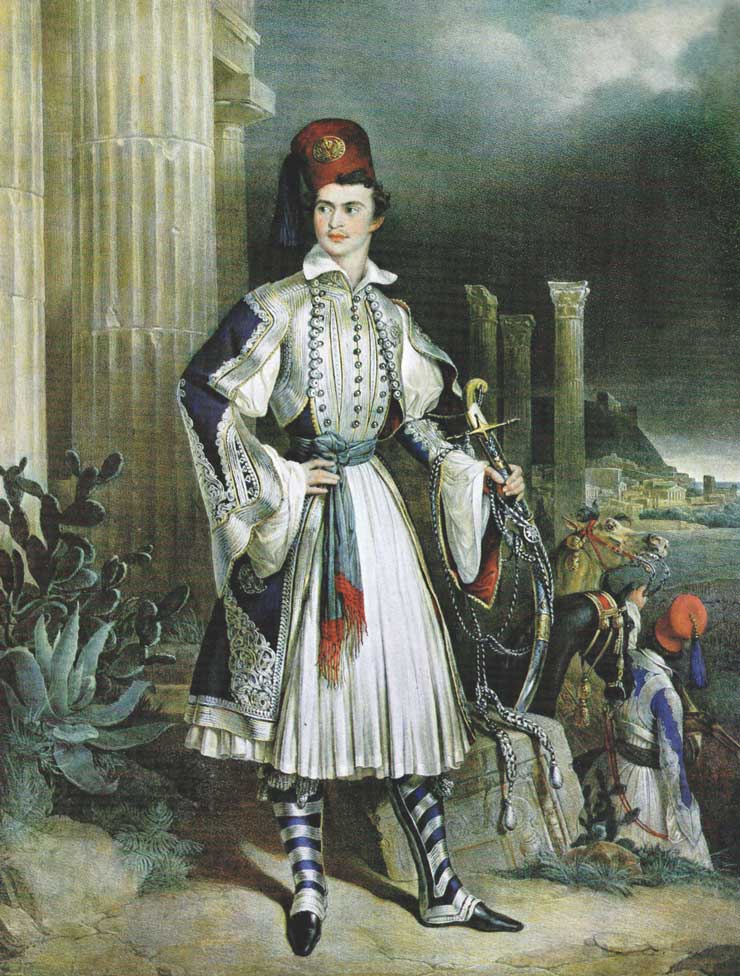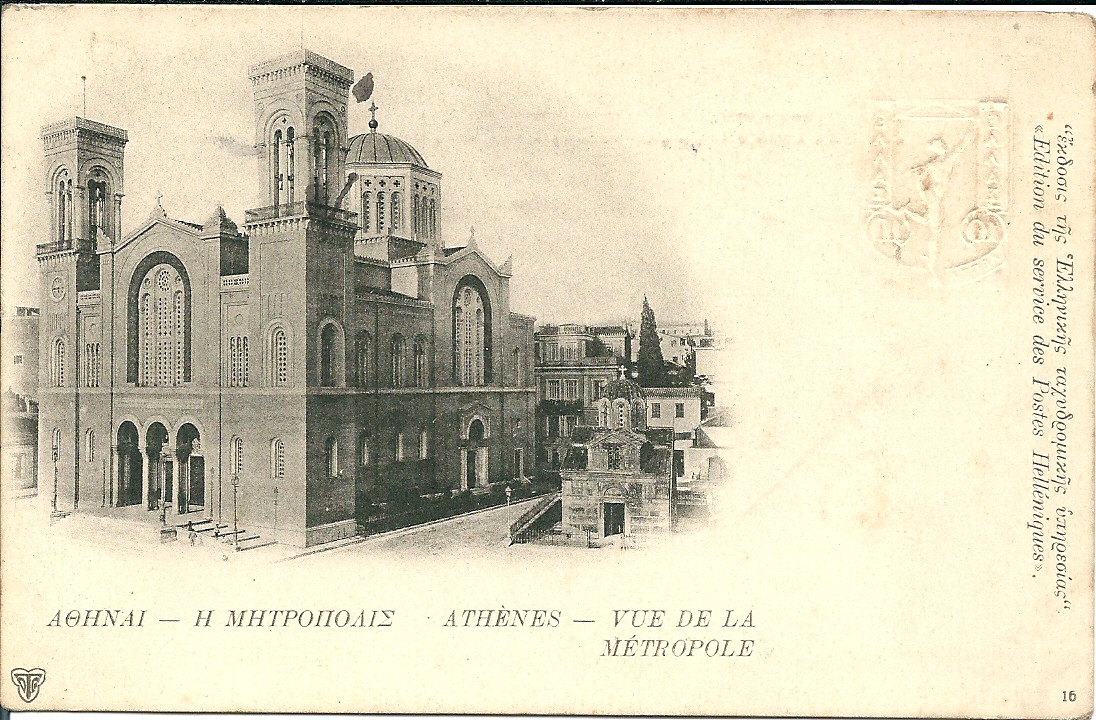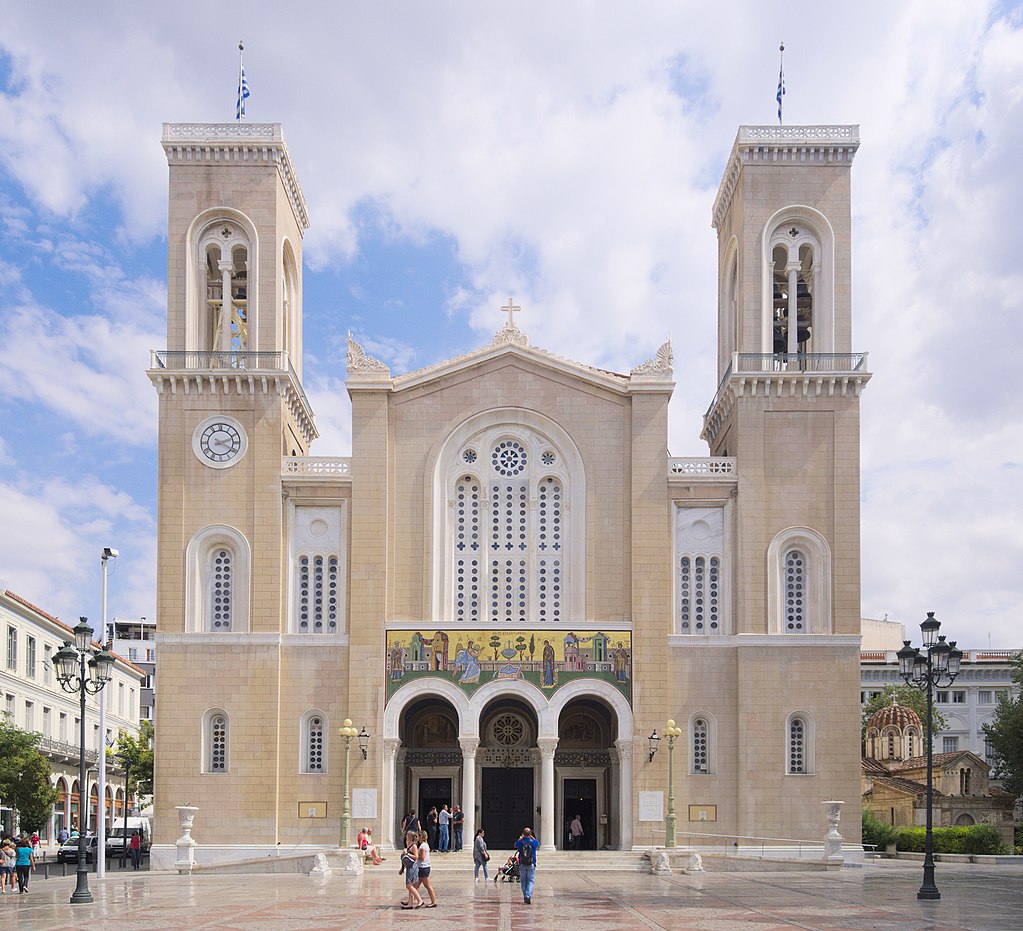by Susan Flantzer
© Unofficial Royalty 2022

Metropolitan Cathedral of the Annunciation; Credit – By George E. Koronaios – Own work, CC BY-SA 4.0, https://commons.wikimedia.org/w/index.php?curid=78384160
The Metropolitan Cathedral of the Annunciation, located in central Athens near the Acropolis, is a three-aisled, domed basilica designed in a mixed Romanesque–Renaissance–Byzantine style.
Some Greek History

King Otto in traditional Greek dress; Credit – Wikipedia
Greece’s monarchy came late and lasted for a total of 130 years. Greece was part of the Ottoman Empire from the 15th century until 1821 when Greece declared its independence. The Greeks and the Ottoman Empire fought the Greek War of Independence (1821 – 1832), and with the help of the three Great Powers – France, Russia, and the United Kingdom – the Ottoman Empire was finally defeated. In 1832, the Convention of London established Greece as a kingdom, and the Great Powers appointed 17-year-old Prince Otto of Bavaria, the second son of King Ludwig I of Bavaria, to be the new kingdom’s first king. Having dismissed his regency council in 1835 when he came of age, Otto ruled as an absolute monarch for a few years, until uprisings by the Greek people occurred, demanding a constitution. Otto had no recourse but to give in to the demands and allow for a constitution and the establishment of a Greek National Assembly. In 1862, while Otto was away from Athens, a coup d’état led to the formation of a provisional government, and Otto was deposed.

King George I in 1864; Credit – Wikipedia
Still wanting a monarchy, Greece began searching for a new king. While several European princes were put forward as possible kings, the Greek people and the Great Powers soon chose Prince Vilhelm of Denmark, the second son of King Christian IX of Denmark, as their king. On March 30, 1863, the 17-year old Vilhelm was unanimously elected by the Greek National Assembly and took the name King George I of the Hellenes. In 1924, the Second Hellenic Republic was declared and the monarchy was abolished. The monarchy was restored in 1935. On April 21, 1967, a coup d’état led by a group of army colonels took over Greece. King Constantine II remained the head of state in exile until June 1, 1973, when the monarchy was officially abolished.
The Greek government did not permit former King Constantine II to return to Greece until 1981 when he and his family were allowed to enter Greece for several hours to attend the burial of his mother Queen Frederica in the Royal Cemetery at Tatoi Palace. Constantine and his family made a private visit to Greece in 1993. After 2003, when a property dispute between Constantine and the Greek government was resolved, Constantine and his family were able to make visits to Greece and purchase a summer home there. In 2013, former King Constantine II permanently returned to reside in Greece.
********************
History of the Metropolitan Cathedral of the Annunciation in Athens, Greece

1918 postcard of the Metropolitan Cathedral; Credit – Wikipedia
Like the modern Greek monarchy, the major cathedral in Athens is also not old. In 1833, with the establishment of the Kingdom of Greece, the new government decided to form its own national church and broke away from the Patriarch of the Orthodox Churches in Constantinople, the capital of the Ottoman Empire, now Istanbul, Turkey. Known as the Church of Greece, it is part of the worldwide Greek Orthodox Church. Authority of the Church of Greece is vested in the Holy Synod of the Church of Greece, comprised of diocesan bishops who have metropolitan status. The head of the Church of Greece is the Archbishop of Athens and All Greece.
A new cathedral in the capital city of Athens was part of a comprehensive building program that King Otto carried out. The cornerstone of the new cathedral was laid in the presence of King Otto on Christmas Day 1842. The relationship of the new Church of Greece with King Otto and his wife Amalia of Oldenburg, who he married in 1836, was strained. Although King Otto agreed that his children would be raised in the Greek Orthodox religion, he refused to convert from Roman Catholicism. Likewise, Queen Amalia refused to convert from Lutheranism. Otto and Amalia never had children and their refusal to convert to the Greek Orthodox religion led to them being greatly disliked by the Greek people and were contributing factors to King Otto being deposed in 1862.

King Otto and Queen Amalia in the Metropolitan Cathedral; Credit – Wikipedia
The Metropolitan Cathedral of the Annunciation was built in several stages, and four architects worked on its construction: Danish architect Theophilus von Hansen (1842 – 1843), Greek architect Dimitrios Zezos (1846 – 1857), French architect Francois Boulanger, and Greek architect Panagiotis Kalkos (1857 – 1862). Marble from 72 demolished churches was used to build the cathedral. Work was stopped on the cathedral for three years, 1843 – 1846, due to financial problems. On May 21, 1862, the completed cathedral was dedicated to the Annunciation of the Virgin Mary in the presence of King Otto and Queen Amalia.

The Metropolitan Cathedral in 2008 while it was still being repaired due to the damage caused by the 1999 earthquake: Credit – Από Badseed – Own work CC BY-SA 3.0, https://commons.wikimedia.org/w/index.php?curid=4309396
The cathedral was damaged by an earthquake on September 7, 1999. Renovations and repairs were extensive and the scaffolding was not removed until 2016.
********************
The Exterior of the Metropolitan Cathedral of the Annunciation

Exterior of the Metropolitan Cathedral in 2016 after the end of the repair work caused by the 1999 earthquake; Credit – Από C messier – Έργο αυτού που το ανεβάζει, CC BY-SA 4.0, https://commons.wikimedia.org/w/index.php?curid=51359657
The exterior of the cathedral is in a simple Byzantine-modern style with two bell towers. Above the main doors is a mosaic representing the Annunciation, the announcement of the Archangel Gabriel to Mary that she would conceive and bear a son through a virgin birth and become the mother of the Son of God.

The mosaic of the Annunciation above the main doors; Credit – By Κυριάκος Κ. – Own work, CC BY-SA 4.0, https://commons.wikimedia.org/w/index.php?curid=84743057
********************
The Interior of the Metropolitan Cathedral of the Annunciation

The layout of the traditional interior of an Orthodox church; Credit – By Phiddipus at en.wikipedia – self-made, Attribution, https://commons.wikimedia.org/w/index.php?curid=13396583
Orthodox churches are set up differently than other Christian churches. They are divided into three main parts: the narthex, the nave, and the sanctuary.
The narthex is the connection between the church and the outside world. It used to be the practice that non-Orthodox people had to remain in the narthex but this practice has mostly fallen into disuse.

The nave looking toward the iconostasis; Credit – By George E. Koronaios – https://www.flickr.com/photos/140911325@N02/, CC BY-SA 2.0, https://commons.wikimedia.org/w/index.php?curid=99501816
The congregation stands in the nave during services. Traditionally there is no sitting during Orthodox services and so Orthodox churches usually do not have pews or chairs. The Metropolitan Cathedral has no pews but chairs are sometimes used.

The iconostasis; Credit – © Ad Meskens / Wikimedia Commons Own work, CC BY-SA 4.0, https://commons.wikimedia.org/w/index.php?curid=83302715
In Orthodox Christianity, an iconostasis is a wall of icons and religious paintings that divides the sanctuary from the nave. The sanctuary is where the Eucharist or Divine Liturgy is performed behind the iconostasis. The iconostasis usually has three doors, one in the middle and one on either side. The middle door is traditionally called the Beautiful Gate and is only used by the clergy. The doors on either side are called the Deacons’ Doors or Angel Doors as they often have depicted on them the Archangels Michael and Gabriel. These doors are used by deacons and servers to enter the sanctuary. Traditionally, only males may enter the sanctuary, however, no one may enter the sanctuary without a blessing from the priest or bishop.

Decorations of the interior of the Metropolitan Cathedral; Credit – By C messier – Own work, CC BY-SA 4.0, https://commons.wikimedia.org/w/index.php?curid=73200702
The interior of the Metropolitan Cathedral of the Annunciation is richly decorated with frescoes, icons, and stone carvings.

Icon of the Virgin Mary and Infant Jesus; Credit- By Tzim78 – Own work, CC BY-SA 4.0, https://commons.wikimedia.org/w/index.php?curid=37693059
The cathedral has the tombs of Saint Philothei of Athens (1522 – 1589) and Saint Georgios V, Patriarch of Constantinople (1746 – 1821), who were killed by the Ottoman Turks while Greece was part of the Ottoman Empire. They are revered as martyrs for the freedom of Greece and the Orthodox faith.
Shrine of Saint Georgios V, Patriarch of Constantinople; Credit – By Χρήστης Templar52 – Transferred from el.wikipedia to Commons by Alaniaris using CommonsHelper.(Original text: Φωτογράφηση ρξ ιδίων), Attribution, https://commons.wikimedia.org/w/index.php?curid=4313193
********************
Royal Events at the Metropolitan Cathedral of the Annunciation
Wedding of Prince Philippos and Nina Nastassja Flohr in 2021
The Metropolitan Cathedral has been the site of important ceremonies including weddings and funerals of notable personalities including Greek royalty. It is likely that there would have been more royal events at the Metropolitan Cathedral had the Greek royals not been in exile from 1924 – 1935 during the Second Hellenic Republic and from 1967 – 2003, after the monarchy was abolished and until former King Constantine II was allowed to once again to enter Greece. Most recently, the religious wedding of Prince Philippos, the youngest child of former King Constantine II, and Nina Nastassja Flohr was held at the Metropolitan Cathedral on October 23, 2021.

Christening of Crown Prince Pavlos of Greece in 1967; Credit – https://www.pinterest.com/pin/385761524301918610/
Royal christenings held at the Metropolitan Cathedral of the Annunciation include:
- July 20, 1940 – Christening of the future King Constantine II, son of King Paul I
- June 29, 1967 – Christening of Crown Prince Pavlos, son of King Constantine II
Embed from Getty Images
Wedding of King Constantine II of Greece and Princess Anne-Marie of Denmark in 1964
Royal weddings held at the Metropolitan Cathedral of the Annunciation include:
- October 27, 1889 – Wedding of the future King Constantine I, son of King George I, and Princess Sophie of Prussia
- December 12, 1907 – Wedding of Prince George, son of King George I, and Princess Marie Bonaparte
- March 10, 1921 – Wedding of Princess Helen, daughter of King Constantine I, and the future King Carol II of Romania
- January 8, 1938 – Wedding of the future King Paul I, son of King Constantine I, and Princess Frederica of Hanover
- May 14, 1962 – Wedding of Princess Sophia, daughter of King Paul I, and the future King Juan Carlos I of Spain
- September 18, 1964 – Wedding of King Constantine II, son of King Paul I, and Princess Anne-Marie of Denmark
- October 23, 2021 – Wedding of Prince Philippos, son of the former King Constantine II, and Nina Nastassja Flohr
The coffin of Grand Duchess Elena Vladimirovna of Russia, wife of Prince Nicholas of Greece, is carried by members of the Royal Guard at her funeral in 1957, followed by King Paul of Greece
Royal funerals held at the Metropolitan Cathedral of the Annunciation include:
- April 2, 1913 – Funeral of King George I (assassinated), son of King Christian IX of Denmark
- February 15, 1938 – Funeral of Prince Nicholas, son of King George I
- January/February 1940 – Funeral of Prince Christopher, son of King George I
- December 1940 – Funeral of Princess Maria, son of King George I
- April 6, 1947 – Funeral of King George II, son of King Constantine I
- March 20, 1957 – Funeral of Elena Vladimirovna of Russia, Princess of Greece, wife of Prince Nicholas
- December 4, 1957 – Funeral of Prince George, son of King George I
- March 12, 1964 – Funeral of King Paul I, son of King Constantine I
- January 16, 2023 – Funeral of former King Constantine II, son of King Paul I
This article is the intellectual property of Unofficial Royalty and is NOT TO BE COPIED, EDITED, OR POSTED IN ANY FORM ON ANOTHER WEBSITE under any circumstances. It is permissible to use a link that directs to Unofficial Royalty.
Works Cited
- De.wikipedia.org. 2022. Kathedrale Mariä Verkündigung (Athen) – Wikipedia. [online] Available at: <https://de.wikipedia.org/wiki/Kathedrale_Mari%C3%A4_Verk%C3%BCndigung_(Athen)> [Accessed 14 February 2022].
- El.wikipedia.org. 2022. Μητροπολιτικός Ναός Αθηνών – Βικιπαίδεια. [online] Available at: <https://el.wikipedia.org/wiki/%CE%9C%CE%B7%CF%84%CF%81%CE%BF%CF%80%CE%BF%CE%BB%CE%B9%CF%84%CE%B9%CE%BA%CF%8C%CF%82_%CE%9D%CE%B1%CF%8C%CF%82_%CE%91%CE%B8%CE%B7%CE%BD%CF%8E%CE%BD> [Accessed 14 February 2022]. (Greek Wikipedia)
- En.wikipedia.org. 2022. Eastern Orthodox church architecture – Wikipedia. [online] Available at: <https://en.wikipedia.org/wiki/Eastern_Orthodox_church_architecture> [Accessed 14 February 2022].
- En.wikipedia.org. 2022. Iconostasis – Wikipedia. [online] Available at: <https://en.wikipedia.org/wiki/Iconostasis> [Accessed 14 February 2022].
- En.wikipedia.org. 2022. Metropolitan Cathedral of Athens – Wikipedia. [online] Available at: <https://en.wikipedia.org/wiki/Metropolitan_Cathedral_of_Athens> [Accessed 14 February 2022].
- The Royal Watcher. 2022. The Royal Watcher. [online] Available at: <https://royalwatcherblog.com/> [Accessed 14 February 2022]. (for event dates)
- Van Der Kiste, John, 1999. Kings of the Hellenes: The Greek Kings 1863 – 1974. Stroud: Sutton Publishing.
